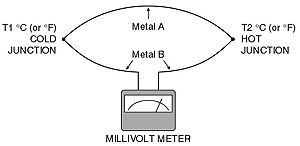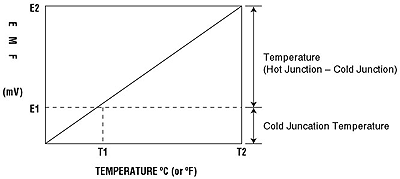| The figures show the temperature-emf curve (not
to scale) and a temperature measuring setup with a thermocouple and
a millivolt meter. Assume the cold and the hot junctions are at T1°C
and T2°C, respectively. According to the temperature-emf table
of the standard, the thermocouple generates emf of E1 mV at the temperature
T1 and E2 mV at T2. The millivolt meter receives the potential difference,
E2 - E1 which corresponds to T2 - T1. In order to obtain T2, we need
to add E1 to the potential difference, E2 - E1 for elimination of
E1. |

 |
An actual example may better clarify the above discussion.
Assume that we are using a Type E thermocouple to measure T2, which
is 550°C (1022°F) and the millivolt meter (more accurately
speaking, the terminals of the millivolt meter) is at room temperature
T1, which is 25°C (77°F). According to the temperature-emf
table of Type E, the thermocouple generates (with reference to °C):
41. 045 mV at 550°C
1.495 mV at 25°C
The potential difference is 39.550 mV.
The millivolt meter displays to 39.550 mV, which corresponds to 531.5°C,
not 550°C. We must make cold junction compensation by adding 1.495
mV to the potential difference, 39.550 mV. |
| M-System has flexible solutions to meet your specific
application and requirements. Consult our Signal Conditioners Data
Library. |
|
 What
is cold junction compensation?
What
is cold junction compensation?
 Temperature
should be measured with the cold junction at 0°C or 32°F. When a
thermocouple or its extension wires are connected to the terminals of a
device like a thermocouple transmitter the cold junction is at the room
temperature T1°C. If both temperatures of the hot and the cold junctions
are above 0°C, the device receives a lower emf than when the cold junction
temperature is 0°C. In order to measure the temperature accurately,
we need to add the emf value which corresponds to T1 to the measured emf.
To add this emf is called cold junction compensation.
Temperature
should be measured with the cold junction at 0°C or 32°F. When a
thermocouple or its extension wires are connected to the terminals of a
device like a thermocouple transmitter the cold junction is at the room
temperature T1°C. If both temperatures of the hot and the cold junctions
are above 0°C, the device receives a lower emf than when the cold junction
temperature is 0°C. In order to measure the temperature accurately,
we need to add the emf value which corresponds to T1 to the measured emf.
To add this emf is called cold junction compensation.